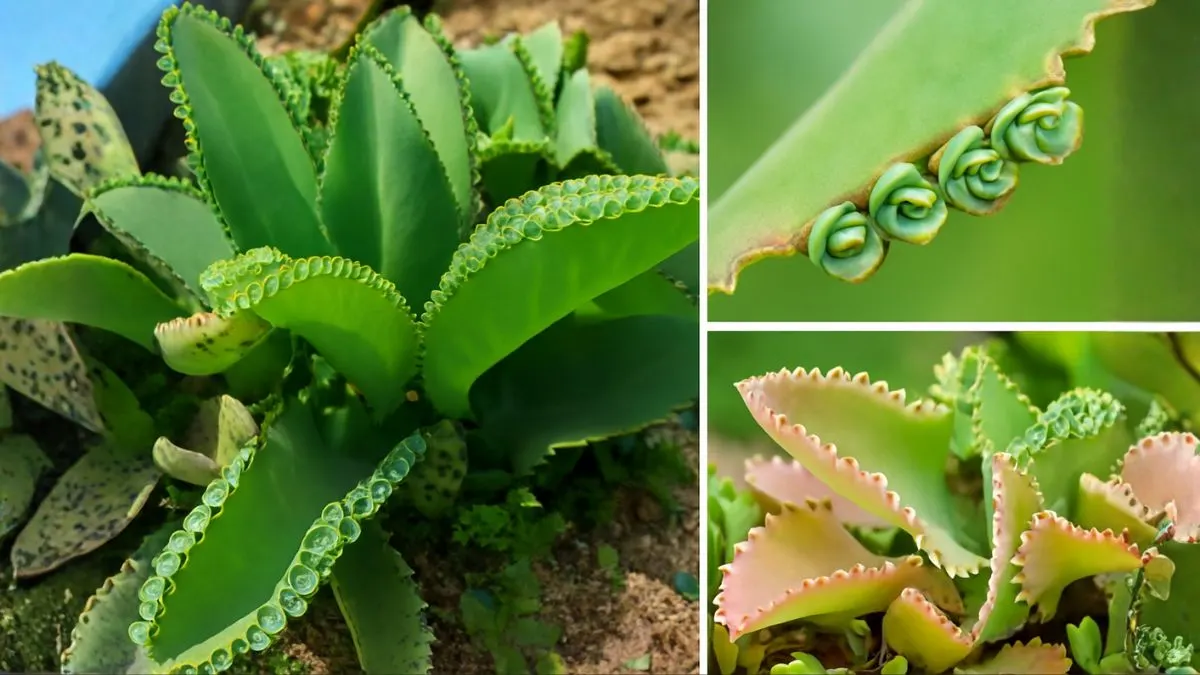Think of a plant that’s so self-sufficient, it can generate its own offspring — on its own leaves! That’s the Mother of Thousands (Kalanchoe daigremontiana) for you. This striking succulent, hailing from Madagascar, is famous for being able to grow baby plants off the edges of its leaves, each one capable of taking root and becoming a whole new plant.
Adored by gardeners in Canada and the US, as well as other cold regions of the world – this is for you if you love beauty but hate work. But every living being, including the Mother of Thousands, wants more than just adoration—it flourishes with care, attention and respect.
What is unique about the Mother of Thousands?

This is because as an atypical succulent, this plant is produced vegetatively rather than by cutting or from seed. That means little plantlets develop along the edges of its leaves, drop off and take root in adjacent soil. Like, it’s literally a plant that never stops giving!
Key Features:
- Tall, cylindrical leaves with babies lining the edges.
- Very rapid in warm, bright conditions.
- Known for resilience and self-propagation.
- Best for indoor containers and a sunny windowsill.
- Beginners and collectors love it for its fascinating growth pattern and natural blossoming.
Step 1: Select the Perfect Light
Lots of bright, indirect light is appreciated by the Mother of Thousands. It can take some direct sun, but too much harsh light will scorch the leaves.
Light Tips:
- Stand near an east or south-facing window.
- Keep away from direct midday sun, especially in summer.
- If kept indoors, turn the pot once a week to promote even growth.
- In the winter, supplement light with a grow lamp to keep its bright green appearance.
Also Read: Tree Saga: The Sita Ashoka Tree and Its Timeless Symbolism
Step 2: Choose the Right Soil
One of the largest secrets to success is the soil. You’ll prefer a well-drained potting mix that imitates this plant’s rocky native habitat.
Mother of Thousands likes to dry out and needs fast-draining, gritty soil (like we’ve said already). You can buy a cactus or succulent mix, or make your own:
- 2 parts potting soil
- 1 part perlite
- 1 part coarse sand
Have a pot with drainage holes so the roots don’t sit in water.
Step 3: Sow and Propagate
If you’re growing from seeds or baby plantlets, timing and technique are key. Sow in early spring on the surface of soil when it has begun to warm up.
Propagation Steps:
- Carefully pluck baby plantlets from the rim of a mature plant.
- Just put them on moist, gritty soil; don’t bury them.
- Mist lightly and set in a warm, bright place.
- Roots develop in 1–2 weeks.
And before you know it: dozens of miniature versions of your mother plant will be sprouting away merrily!
Step 4: Water Mindfully
Mother of Thousands stores water in its fleshy leaves, and excess watering is a frequent error.
Watering Rules:
- Water when the top inch of soil is dry.
- Be sure all excess water drains away.
- Allow to dry out between winter waterings to avoid root rot.
- When in doubt, remember — it’s better to underwater than overwater a succulent.
Also Read: Tangled Heart Plant: The Perfect Indoor Vine That Loves Neglect!
Step 5: Fertilize Occasionally
While this plant is not high-maintenance, a little fertilizer helps keep it robust.
Fertilizing Tips:
- Fertilize with diluted succulent fertilizer every 6–8 weeks in spring and summer.
- Do not fertilize in winter, the season of reduced growth.
- Too much fertilizer can cause legginess or poor-quality leaves.
Balanced care will preserve the babies on every single leaf year-round of your Mother of Thousands.
Step 6: Runners and Maintenance
Your plant may get too big for its container as it grows. Repot it into a slightly larger pot with fresh well-drained potting mix every 1–2 years.
Repotting Steps:
- Lift the plant out of its pot.
- Shake off old soil and examine roots.
- Cut off any rotten or mushy roots.
- Replant in a new pot with fresh soil and allow it to develop.
Pro tip: The plantlets themselves may jostle loose during repotting — collect and pot them up too!
Step 7: Respect Its Space
This plant is no shrinking violet. Since it’s a self-sower, outdoor planting can cause intense spread. In tropical areas, it’s even regarded as invasive.
If you’re in Canada or the Northern US, this won’t be a problem as winter prevents its spread. But for those in warmer zones, grow it in containers to curb spreading.
For this plant to grow, it needs a little gardening, mindfulness, and reverence.
Also Read: Begonia Magic: The One Flower That Blooms Indoors Without Fuss
Common Problems and Solutions
Problem |
Cause |
Solution |
Yellow leaves |
Overwatering |
Let soil dry between waterings |
Droopy stems |
Lack of sunlight |
Move to a brighter location |
No baby plantlets |
Nutrient deficiency |
Add a light succulent fertilizer |
Leaf spots |
Fungal issue |
Improve air circulation and use sterilized soil |
Your plant will remain healthy all year with regular monitoring.
Personal Experience
When I first brought my Mother of Thousands home, I didn’t anticipate how fast it would multiply! In a month it had numerous baby plantlets all along the edges of its leaves. I started getting these little volunteers in nearby pots, rooting before I’d even notice!
What I liked best, though, was how tough they turned out to be — I set a few on a fast-draining, gritty soil mix, watered seldom, and everyone survived. It’s really a miracle of nature — to see life grow from something so tiny.
Bonus: How to Keep the Plant in Check
Because it reproduces so readily, you might find yourself with more plants than you know what to do with.
To manage this:
- Regularly remove fallen plantlets.
- Let it grow in a pot indoors.
- Pass new plants on to friends or local plant swaps!
That big-heartedness is the joy of the Mother of Thousands — it’s a plant that begs to be shared.
Conclusion
Raising the Mother of Thousands is a fun adventure — one that instils patience, respect, and an admiration for nature’s ingenuity. This feather-leafed succulent loves quick-draining soil, the right light, and minimal care to reward you with generations of baby plants.
And keep in mind, this succulent not only grows — it flourishes on its own. Whether you start with potting soil in early spring or a single baby plantlet, your Mother of Thousands will amaze you with its strength and glamour.
So let this self-sowing marvel be a reminder to us all: with proper circumstance — anything can blossom.






